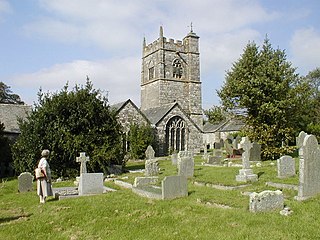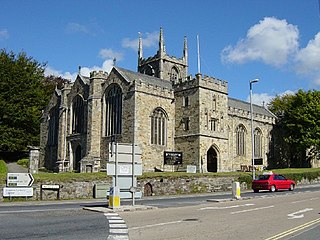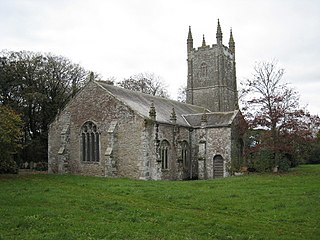
Bodmin is a town and civil parish in Cornwall, England, United Kingdom. It is situated south-west of Bodmin Moor.

St Austell is a town in Cornwall, England, 10 miles (16 km) south of Bodmin and 30 miles (48 km) west of the border with Devon.

St Columb Major is a town and civil parish in Cornwall, England, United Kingdom. Often referred to locally as St Columb, it is approximately seven miles (11 km) southwest of Wadebridge and six miles (10 km) east of Newquay The designation Major distinguishes it from the nearby settlement and parish of St Columb Minor on the coast. An electoral ward simply named St Columb exists with a population at the 2011 census of 5,050. The town is named after the 6th-century AD Saint Columba of Cornwall, also known as Columb.

Advent is a civil parish on the north-western edge of Bodmin Moor in north Cornwall, England. The English name St Adwenna derives from the Cornish Adhwynn and lies in the Registration District of Camelford.

Altarnun is a village and civil parish in Cornwall, England, United Kingdom. It is located 7 miles (11 km) west of Launceston on the north-eastern edge of Bodmin Moor at grid reference SX 223 811.

Blisland is a village and civil parish in Cornwall, England, United Kingdom. It is approximately five miles northeast of Bodmin. According to the 2001 census, the parish had a population of 565. This had increased to 608 at the 2011 census.

St Enoder is a civil parish and hamlet in Cornwall, United Kingdom. The hamlet is situated five miles (8 km) southeast of Newquay. There is an electoral ward bearing this name which includes St Columb Road. The population at the 2011 census was 4,563.

Cubert is a village in Cornwall, England, United Kingdom. It is three miles (5 km) south-southwest of Newquay and is in the civil parish of Cubert.
St Kew is a village in Cornwall, England, United Kingdom. It is also the name of the civil parish, which includes the church town, St Kew, and nearby St Kew Highway.

St. Enodoc Church, Trebetherick is a chapel in the parish of St Minver. It is located to the south of the village of Trebetherick, Cornwall, England, United Kingdom. It is a Grade I listed building.
Laneast is a village and civil parish in Cornwall, England, United Kingdom. It lies above the River Inny valley, about six miles (11 km) west of Launceston. The population in the 2001 census was 164, increasing to 209 at the 2011 census.

St Winnow is a civil parish in Cornwall, England, United Kingdom. Its name may be connected with either that of Saint Winnoc or Saint Winwaloe. It has a population of 304, which had increased to 328 at the 2011 census. The church town is on the east bank of the River Fowey south of Lostwithiel. Part of the village of Lerryn lies within the parish as does the Chapel of St Nectan. The Redlake Meadows & Hoggs Moor, a Site of Special Scientific Interest is also in the parish.

Lanivet is a village and civil parish in Cornwall, England, United Kingdom. The village is situated approximately 2+1⁄2 miles (4.0 km) southwest of Bodmin, and before the Bodmin by-pass was built, the A30 road between London and Land's End passed through the village. The Saints' Way long-distance footpath passes Lanivet near its half-way point.

St Michael's Church is the Church of England parish church of Shotwick, Cheshire, England. It a Grade I listed building. It has a Norman doorway but most of the church is Gothic. Its furniture includes some ancient items. In the churchyard are several structures that are Grade II listed. The church is an active parish church in the Diocese of Chester, the archdeaconry of Chester and the deanery of Wirral South. Its benefice is combined with that of St Nicholas, Burton.

The Church of St Hilary is an Early English–style church in the village of St Hilary, Cornwall, United Kingdom. It features a 13th-century tower. Following a fire in 1853, the remainder of the church was rebuilt two years later by William White. The church is dedicated to Saint Hilary of Poitiers and is a Grade I listed building. The architecture is described in Pevsner's Buildings of England: Cornwall.

St Petroc's Church, Bodmin, also known as Bodmin Parish Church, was a Roman Catholic Church until the reformation and is currently an Anglican parish church in the town of Bodmin, Cornwall, England, United Kingdom.
Shotwick is a former civil parish, now in the parish of Puddington, in Cheshire West and Chester, England. It contains 23 buildings that are recorded in the National Heritage List for England as designated listed buildings. Of these, one is listed at Grade I, the highest grade, two are listed at Grade II*, the middle grade, and the others are at Grade II. Apart from the village of Shotwick, the parish is entirely rural. Most of the listed buildings are in the village, and include houses, St Michael's Church and structures in the churchyard, and Shotwick Hall with associated structures. Outside the village, the listed buildings are domestic or related to farming.

St Piran's Church is an active Anglican parish church in Perranarworthal, Cornwall, England. It is part of a united benefice consisting of eight churches, the Eight Saints Cluster, in the parishes of Stithians with Perran-Ar-Worthal and Gwennap. The benefice has four licensed clergy and four readers. The church, dedicated to Saint Piran, is in the Carnmarth, North deanery, the archdeaconry of Cornwall and the Diocese of Truro. The church was granted Grade II* listed status in May 1967. The churchyard contains several listed chest tombs and headstones.

The Church of Saint Winwaloe is the Grade I listed parish church of Gunwalloe in Cornwall, England.

St Hermes’ Church, St Erme is a Grade II* listed parish church in the Church of England Diocese of Truro in St Erme, Cornwall, England, UK.




















